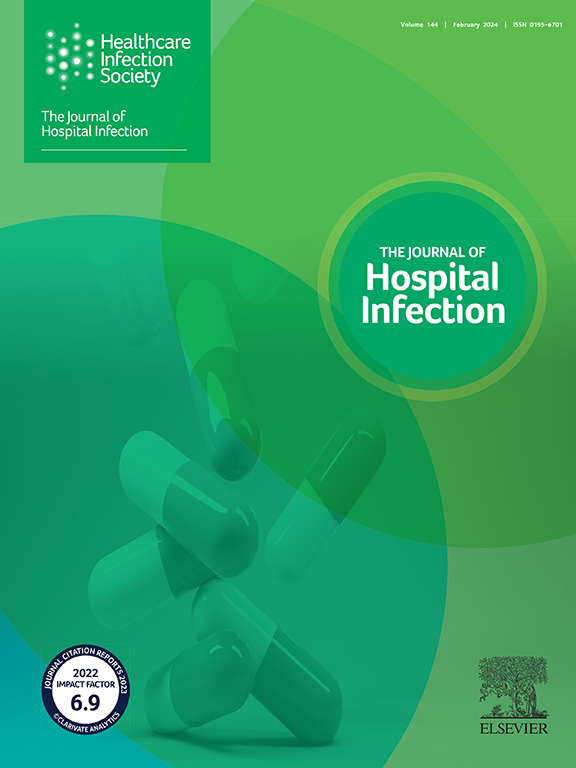Evaluating the risk of duodenoscope-associated colonization and duodenoscope-associated infection: a prospective observational study
IF 3.9
3区 医学
Q1 INFECTIOUS DISEASES
引用次数: 0
Abstract
Background
The risk of duodenoscope-associated colonization (DAC) and infection (DAI) after endoscopic retrograde cholangiopancreatography (ERCP) with a contaminated duodenoscope remains unknown. Determining the incidence of these events is crucial for developing prevention strategies.
Aim
To assess the incidence of DAC and DAI.
Methods
This prospective observational study included adult patients who underwent ERCP from January 2022 to December 2023. Duodenoscopes were sampled prior to each procedure. Contamination was defined as the presence of micro-organisms of gut or oral origin (MGO). Post ERCP, upon availability of culture results, patients exposed to contaminated duodenoscopes were asked to provide a stool sample and were followed for six months. Micro-organisms isolated from patient samples and clinical cultures were compared with those found in the duodenoscopes. Whole-genome sequencing (WGS) was used to confirm DAC or DAI.
Findings
Among 341 ERCP patients, 73 (21.4%) procedures involved MGO-contaminated duodenoscopes. No duodenoscope-associated outbreaks occurred during the study. Stool samples were returned by 45 of the 73 patients (61.6%). Additionally, 80 MGOs from clinical cultures and 37 residual samples were stored. WGS was performed on eight duodenoscope–patient micro-organism pairs from six patients. No DAC or DAI cases were detected.
Conclusion
In a non-outbreak setting, supported by monthly routine microbiological surveillance and a quarantine protocol for duodenoscopes, the risk of DAC and DAI appears low. These findings suggest limited value in intensive patient surveillance for DACs/DAIs. Further research is warranted to confirm these results and address knowledge gaps regarding risk factors for DACs and DAIs.
评估十二指肠镜相关定殖(DAC)和十二指肠镜相关感染(DAI)的风险:一项前瞻性观察研究。
背景和研究目的:污染十二指肠镜下逆行胆管胰胆管造影(ERCP)后十二指肠镜相关菌落(DAC)和感染(DAI)的风险尚不清楚。确定这些事件的发生率对于制定预防战略至关重要。本研究旨在评估DACs和DAIs的发生率。方法:这项前瞻性观察性研究纳入了2022年1月至2023年12月接受ERCP的成年患者。每次手术前都进行十二指肠镜取样。污染被定义为肠道或口腔微生物(MGO)的存在。ercp后,在获得培养结果后,要求暴露于受污染十二指肠镜下的患者提供粪便样本,并随访6个月。从患者样本和临床培养中分离的微生物与十二指肠镜中发现的微生物进行了比较。采用全基因组测序(WGS)确认DAC或DAI。结果:在341例ERCP患者中,73例(21.4%)手术涉及mgo污染的十二指肠镜。研究期间未发生十二指肠镜相关的疾病暴发。73例患者中有45例(61.6%)返回粪便样本。另外,保存临床培养的80个mgo和37个残留样本。对6例患者的8对十二指肠镜-患者微生物进行WGS。未发现DAC或DAI病例。结论:在非疫情环境下,每月例行微生物监测和十二指肠镜隔离方案的支持下,DAC和DAI的风险似乎很低。这些发现表明,对患者进行DACs/DAIs的强化监测价值有限。需要进一步的研究来证实这些结果,并解决关于DACs和DAIs风险因素的知识差距。
本文章由计算机程序翻译,如有差异,请以英文原文为准。
求助全文
约1分钟内获得全文
求助全文
来源期刊

Journal of Hospital Infection
医学-传染病学
CiteScore
12.70
自引率
5.80%
发文量
271
审稿时长
19 days
期刊介绍:
The Journal of Hospital Infection is the editorially independent scientific publication of the Healthcare Infection Society. The aim of the Journal is to publish high quality research and information relating to infection prevention and control that is relevant to an international audience.
The Journal welcomes submissions that relate to all aspects of infection prevention and control in healthcare settings. This includes submissions that:
provide new insight into the epidemiology, surveillance, or prevention and control of healthcare-associated infections and antimicrobial resistance in healthcare settings;
provide new insight into cleaning, disinfection and decontamination;
provide new insight into the design of healthcare premises;
describe novel aspects of outbreaks of infection;
throw light on techniques for effective antimicrobial stewardship;
describe novel techniques (laboratory-based or point of care) for the detection of infection or antimicrobial resistance in the healthcare setting, particularly if these can be used to facilitate infection prevention and control;
improve understanding of the motivations of safe healthcare behaviour, or describe techniques for achieving behavioural and cultural change;
improve understanding of the use of IT systems in infection surveillance and prevention and control.
 求助内容:
求助内容: 应助结果提醒方式:
应助结果提醒方式:


